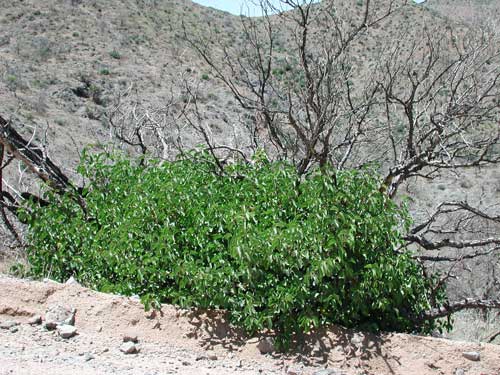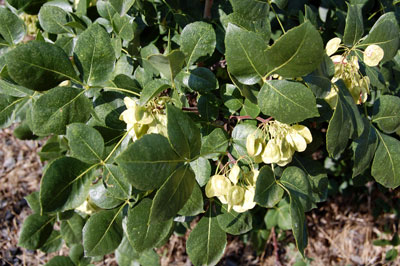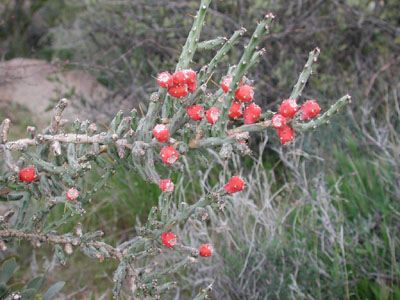Shrubs and Trees
Common species listed first:
- Catclaw Acacia -- Acacia greggii
- Burrobrush -- Hymenoclea salsola
- Velvet Mesquite (Prosopis velutina)
- Sugar Berry -- Rhus ovata
- Red Willow -- Salix laevigata
- Fremont Cottonwood -- Populus fremontii
- Desert Tobacco (Nicotiana trigonophylla)
- Netleaf Hackberry -- Celtis laevigata reticulata
- Chaparral Honeysuckle (Lonicera interrupta)
- Canyon Grape -- Vitis arizonica
- Velvet Ash -- Fraxinus velutina
- Scrub Live Oak -- Quercus turbinella
- Arizona Sycamore -- Platanus wrightii
- Bigroot -- Marah gilensis
- Desert Rock Pea -- Lotus rigidus
- Red-berry Barberry -- Mahonia haematocarpa
- Desert Hackberry (Celtis pallida) -- Many large plants growing along the washes particularly in protected coves that escape the occasional scouring flood.
- Sand Wash Groundsel -- Senecio flaccidus
- Ragged Rock Flower -- Crossosoma bigelovii
- Desert Honeysuckle -- Anisacanthus thurberi
- Western Soapberry -- Sapindus saponaria
- Holly-leaf Buckthorn -- Rhamnus crocea
- Desert Straw -- Stephanomeria pauciflora
- Creosote Bush (Larrea tridentata) -- on ridges and more abundant downstream towards the Verde.
- Foothills Palo Verde (Cercidium microphyllum) --
- Golden Eye (Viguiera deltoidea) -- fairly common on rocky slopes.
- Desert Senna -- Senna covesii
- Desert Willow -- Chilopsis linearis
- Jojoba -- Simmondsia chinensis
- Milkweed Vine -- Funastrum cyanchoides
- Nightshade -- Solanum douglasii
- Hop Tree -- Ptelea trifoliata
- Snapdragon Vine -- Maurandella antirrhiniflora
- Brittle Bush (Encelia farinosa)
- Wolfberry (Lycium spp.) -- several species that are hard to distinguish when not in flower/fruit.
- Canyon Ragweed -- Ambrosia ambrosioides
- Seep Baccharis -- Baccharis salicifolia
- Woolly Bursage -- Ambrosia eriocentra
- Water Weed -- Baccharis sergiloides
- Desert Mistletoe (Phoradendron californicum)
- Globe Mallow (Sphaeralcea ambigua) -
- Graythorn -- Ziziphus obtusifolia
- Sweet Bush -- Bebbia juncea
- San Felipe Marigold -- Adenophyllum porophylloides
- Turpentine Bush -- Ericameria laricifolia
- Canotia -- Canotia holacantha
- Blue Palo Verde -- Parkinsonia florida
- Foothills Palo Verde -- Parkinsonia microphylla
- Ocotillo (Fouquieria splendens) --
- Desert Broom (Baccharis sarothroides) - Large shrubs within washes.
- Wright Buckwheat (Eriogonum wrightii)
- Janusia (Janusia gracilis) - a twisty, viney plant.
- Goodding's Willow -- Salix gooddingii -- wet spots only
- Ragged Rock Flower -- Crossosoma bigelovii
- Rock Daisy (Perityle emoryi)
- Bladder-Mallow -- Herissantia crispa

Sugar Berry (Rhus ovata) is a plant that will benefit from the fire. It quickly re-establishes from underground roots. The leaves are shiny green. Photo taken May 2008 three years after the fire.

Hop Tree (Ptelea trifoliata) is found on hillsides in Rackensack and also appears to be regrowing well following the fire.
